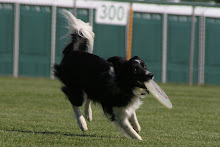Jackpot
I was a little worried about this being the first class of the day. Jackpot involves a gamble, which requires sending your dog to obstacles from a distance. The distance was probably only 5 feet (which she can easily do at home), but in a new place without a toy, I was pretty sure we could not do 5 feet. I was right, she wouldn't send. We just went on and did a few more obstacles, but we were over time trying to get back to the table that stops time. I was bummed at the time, BUT---watching the video later that night, I saw so much that I missed at the time! I saw a dog that performed TWELVE obstacles for me! Five of those were HARD obstacles for her: A-frame twice, dog walk, and two tunnels. She doesn't like tunnels away from home and I guess I can't blame her--being deaf, she completely loses me in a tunnel. She did ALL of that for me! She disengaged twice, but CAME BACK TWICE, and she was with me on the last line of jumps! And what did I do? Pushed her off the last jump since we were over time to go to a 4" table, which is something she'd never seen in her life, and then instead of having something I could praise her for and throw a party, I got another disconnect and had to go collect her. ALL that hard work, and she got nothing for it. Makes complete sense that her next run went like this:
Standard
Jump, jump, disconnect, A-frame, disconnect, jump, disconnect for good. Lots of sniffing. Had to collect up my girly and walk her all the way across the ring. Sad times.
Wildcard
I may be inexperience at trialing, but I'm not completely dumb. I asked my friends to help me come up with a plan to do 1-2 obstacles, throw a party, and be done. I switched to FEO with the judges permission, set her up in front of the last two jumps on the course, had her do her startline stay, but didn't really lead out at all. Ran two jumps with her, and lots of praise! I had her leash in my hand and she grabbed it and tugged a little. She was HAPPY!! So that was a good decision.
Colors
It was tempting to try to run the whole thing, since it was only 8 obstacles and I could avoid the contact obstacles, but there was a tunnel and she had only just done two jumps before, so that would have been 4x as much. I went with a nice looping arc of 4 jumps, partied, and left the ring. Happy girl again!
Jumpers
She did so well the last time, I decided to go for it. 15 obstacles and two tunnels, but I decided I would just skip the tunnels if she didn't want to do them, ignore any off courses or refusals, and just do as much as we could, get to the last jump and party at the end. This one is on the video as well and while it wasn't perfect, it was SO MUCH improved! I didn't make her stay at the start, but I did have a little trouble getting her collar unbuckled, so she unfortunately had time to look around while that was happening. But she started running! Ended up having to skip the first tunnel, but she did the second one! Got some disconnect a couple times, and a quick visit to the judge, but got her back, finished the course, and partied. And LOOK at her!! She understands praise and accepts it as a reward. So cute!
So what next?
1. Build value for contact obstacles and tunnels
2. Next trial, do a short run first to ensure success and build value for the ring, increase number of obstacles as she is ready.
3. Skip contacts and tunnels for a bit in trials, or limit the number
4. We are doing a UKI trial in December, so I will have the opportunity to use rewards in the ring. I will make it a priority to reward after contact obstacles or tunnels





